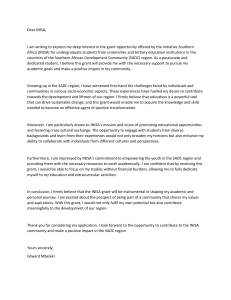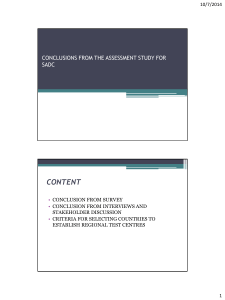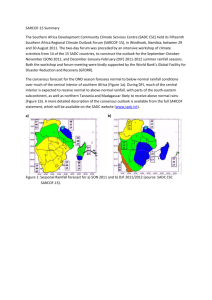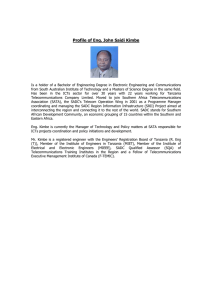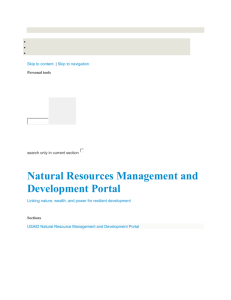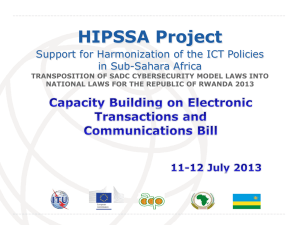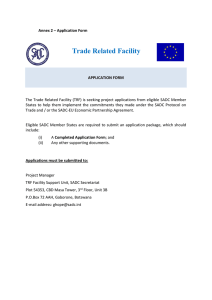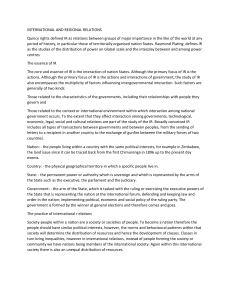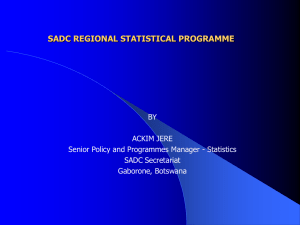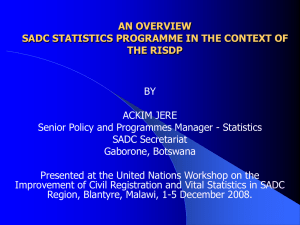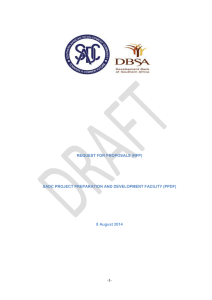Challenges of addressing market failures, the role of NDBs/National DFIs
advertisement
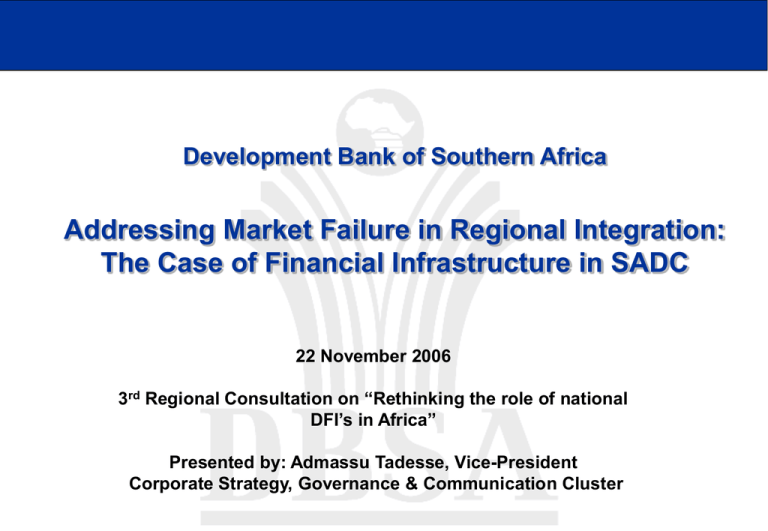
Development Bank of Southern Africa Addressing Market Failure in Regional Integration: The Case of Financial Infrastructure in SADC 22 November 2006 3rd Regional Consultation on “Rethinking the role of national DFI’s in Africa” Presented by: Admassu Tadesse, Vice-President Corporate Strategy, Governance & Communication Cluster The Problem of Low Regional Integration Regional Integration has many dimensions, notably two: Political/governance (political systems, defense, intern’l relations); economic (monetary policy, trade, investment, regulations); The problem of market failure prevails in a number of areas, classically infrastructure (public goods character); industry, agriculture and SMME sectors (information gaps & assymetries); It is important to note that the problem goes well beyond market failure, it includes institutional failure and path dependency (countries get locked into historical patterns and relationships); 2 Some Market & Institutional Failures in Regional Projects Regional development projects benefiting more than one country often have difficulty in reaching financial close Lack of strong sponsors to provide project leadership and management skills (the anchor problem); Upfront investment in feasibility studies; Consensus building and mobilisation of partners; Lack of institutional capacity of RECs & governments (regulatory, policy etc); Lack of sufficient financial scope in region to fund large projects 3 Regional Integration & the Financial Sector A key integration sector is the monetary/financial sector: Promotes stability and macro-economic convergence Facilitates trade in goods and services Facilitates convergence towards regional norm Support emergence of strong regional private sector companies with ability to compete globally There is re-newed focus on regional integration at all levels: this region (AU, NEPAD, SADC & national level) and globally; SADC’s Regional Indicative Strategic Plan (RISDP) highlights importance of integration of financial systems Focus on private sector led growth thus resource mobilization and allocation across region critical 4 Toward an Integrated Financial Sector in the Region RISDP highlights that Financial institutions should provide fuller spectrum of services to both households and firms Harmonisation of policies and regulatory frameworks at regional level required Mobilization of intra-regional savings Co-ordination of central banking required Objectives delineated through protocols e.g. Trade Protocol of 2000 and more recent Finance and Investment Protocol (FIP) Enforcement of FIP expected to Introduce obligations for closer monetary and financial co-operation Harmonization designed to afford stronger rights to investors, protect intellectual property, implement double-tax treaties and introduce regional competition policy 5 Key Features of the Financial Sector in the Region State Ownership of commercial banks Foreign ownership of commercial banks prohibited Angola Botswana Regulation of interest rates Fixed exchange rate Government intervention in the allocation of credit Exchange controls on the current account Exchange controls on the capital account Lesotho Malawi Mauritius Mozambique Namibia South Africa Swaziland Tanzania Zambia Zimbabwe 6 Emergence of Strong Regionally-based Banks Country Namibia ABSA FirstRand Nedcor Standard Bank Botswana Swaziland Lesotho Mozambique Zimbabwe Zambia DRC Angola Malawi Tanzania Madagascar Mauritius 7 DBSA Approach Intervention Goal Banking & Other Credit Institutions Interventions Long term Credit lines in hard & local currency to bank & non-bank financial institutions Direct lending in local currency Aim to Structure projects to facilitate local bank extend, participation improve Active use of T/A as well as advisory services to credit allocation to promote participation in projects; Support non-bank institutions e.g. leasing private enterprise companies (allocation of Identify, partner and co-finance with commercial / investment banks; capital) Technical assistance and capacity building; Ongoing support to national DFIs; Aim to extent financial services to households (mobilization of capital) Capital Markets Interventions Issue long-dated project bonds to develop yield curve and facilitate investment by institutional investors Structure and Invest in private equity funds with mandate to list investees Partial credit enhancement to promote further listings; Advisory and Arranging services Housing finance should be seen as critical sector Secondary issuing of housing portfolio’s which if developed will truly impact development of Promote development of local unit trusts and financial system and economy in general; mutual funds; Microfinance shown to be effective at providing financial services to the poor and should be supported; 8 Profile of DBSA Portfolio & Engagement to Date Focus on allocation of capital to enterprise Credit Lines have been central instrument US$ 81 million to 7 DFIs combined with T/A • EADB, DBZ, PTA, NDC, MDC, DBM US$ 20 million to commercial banks and non-bank institutions Mobilization of local currency Mcel in Mozambique utilizing a guarantee Celtel Tanzania 5 year Swap with Citibank Investment in Private Equity funds – US$ 99 million Bond market – subscription to LHCP issue in Zambia Total investment to date: US$ 265 million Project Preparation 15 feasibility studies for NEPAD projects, with capital value of R32 billion of which 2 projects with capital value of R4.4 billion are in the financing stage ‘Softer’ support given to regional integration include Supported the review of the SADC RISDP to identify and prioritize regional projects Member of the SADC International Cooperating Partner Forum – optimize donor support to SADC Regional Integration Agenda Founder member of the SADC DFI Network – help raise capacity of DFIs and build capital markets 9 Thank You 10
